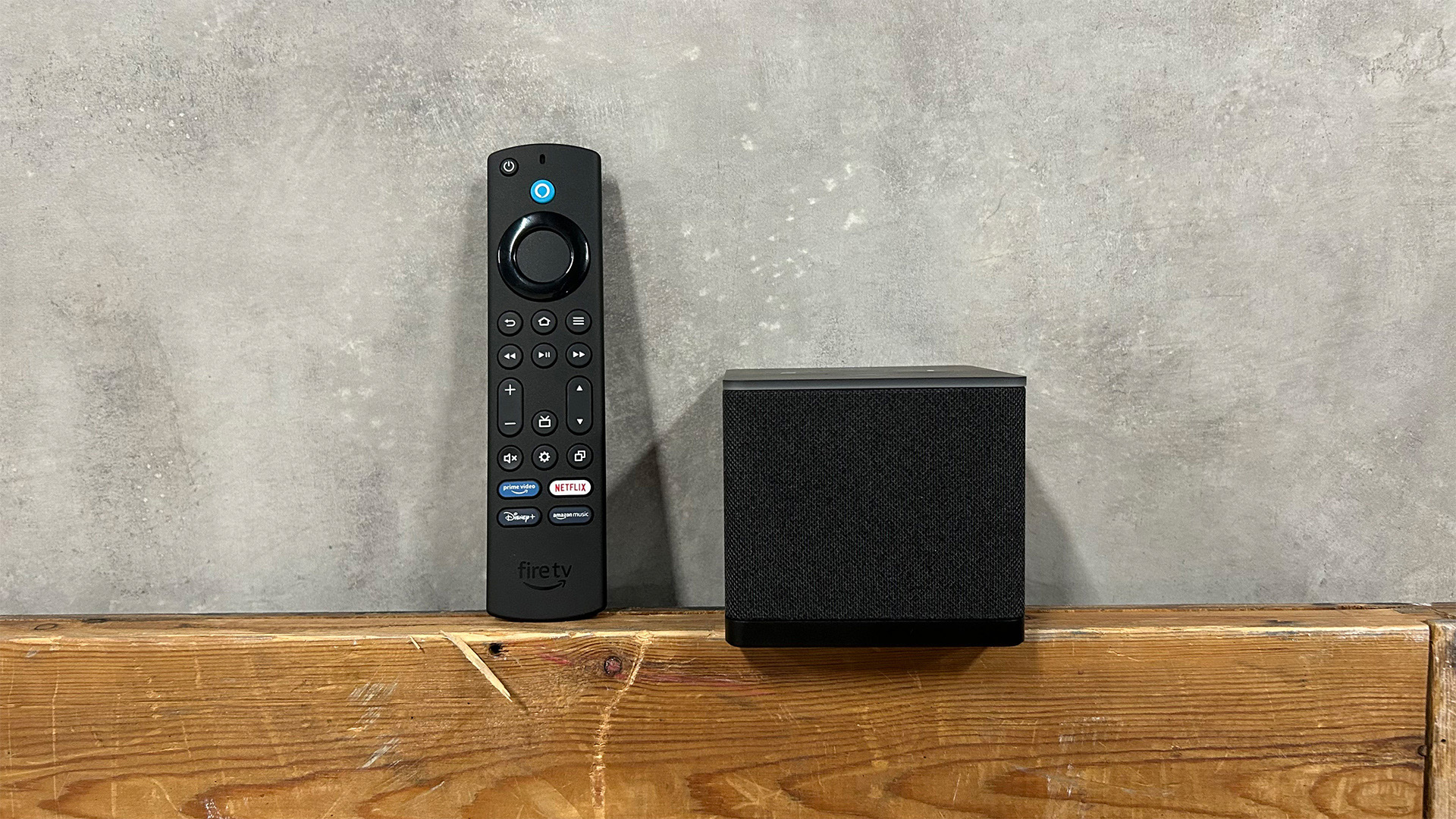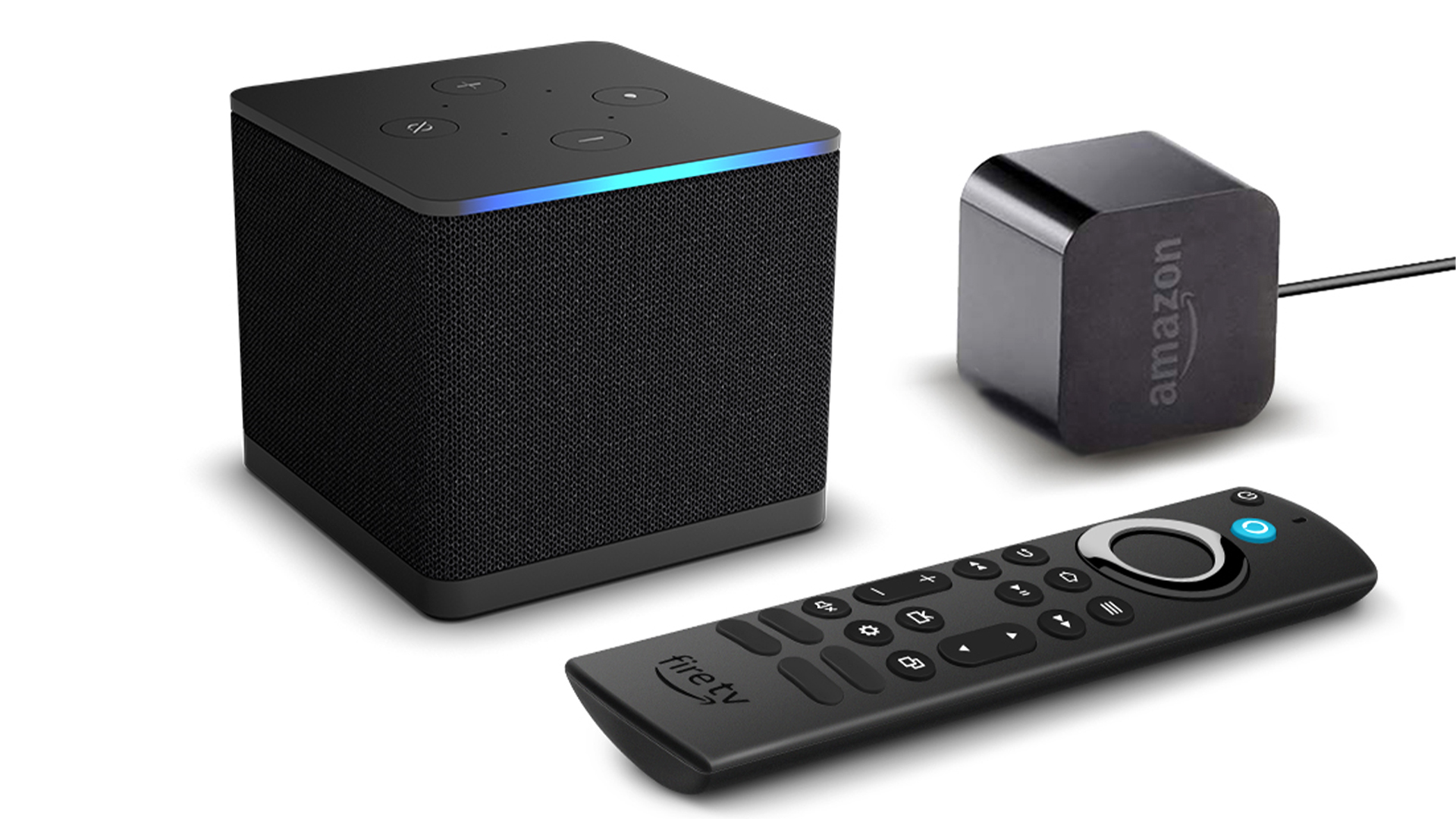
The Amazon Fire TV Cube has finally been given a much-needed refresh after over three years of little development from Amazon. The 3rd Generation Cube gives the boxy media streamer an updated design, a faster processor and Wi-Fi 6E support. Sounds good, right? However, a deeper dive into the picture and sound performance of the new Cube suggests it might not be the complete Amazon package.
Price
The Fire TV Cube is the most expensive Amazon streaming device, coming in at £140 / $140 / AU$219. It’s broadly double the price of the Fire TV Stick 4K Max and it only comes in a 16GB storage and 2GB RAM configuration. The new Fire TV Cube is also more expensive than the second generation model, which retailed for £110 / $120 (around AU$160).
The nearest competitor in the streaming box world is the latest Apple TV 4K, which costs £140 / $130 / AU$219 and includes double the storage capacity and RAM.
Build

As the name suggests, this Fire TV takes on a cube design – although technically speaking it's a cuboid as it measures 86 x 86 x 77mm. It’s slightly redesigned from the previous generation, ditching the black plastic for a fabric mesh that wraps around the front, back and sides of the device.
There is a cutout panel for the Cube’s bountiful selection of ports, which includes both HDMI in and out connections (in the HDMI 2.1 variety), a power socket, an IR extender port, a USB-A socket and an Ethernet connector. This blows its Apple TV competitor out of the water, as that doesn’t include an ethernet connection on the base model or HDMI passthrough on either configuration.
Atop the Fire Cube, you’ll find a selection of buttons including volume up and down as well as buttons to summon and disable the Alexa voice assistant. You may be wondering why the Cube has Alexa controls built into the casework of the streamer itself – it's because the Fire TV Cube acts as an Alexa smart speaker even when your TV is turned off. You’ll see four pinholes on the top of the device for the far-field microphones, as well as an LED strip running across the top edge of the device which illuminates when the assistant is active.
The design of the Fire TV Cube is simple enough to blend into most entertainment set-ups easily, however, it's much taller than the Apple TV and can’t be tucked away like a streaming stick as you’ll need to keep those microphones unobstructed. Thankfully, the woven fabric design means that the Cube looks stylish even when it's fully on display in your entertainment set-up.

Resolution Up to 4K HDR, 60fps
Bluetooth version 5.0 + LE
HDR formats Dolby Vision, HDR10, HDR10+, HLG
Remote control? Yes
Dimensions (hwd) 8.6 X 8.6 X 7.7cm
Weight 513g
Amazon has included its Alexa voice remote with the Fire TV Cube, which also contains a microphone to summon the titular assistant. The handset is the same one you’ll find on every Fire TV device, from the Stick Lite all the way up to the upcoming fully-fledged Omni QLED TV. It includes a D-pad for navigation, volume and channel controls, plus menu, back, home, guide, play/pause, fast forward, rewind, mute, settings and recent buttons – phew!
You’ll also find four shortcuts for quick access to streaming services, the selection of which varies by region. In the UK, it's Amazon Prime Video, Amazon Music, Netflix and Disney Plus, but in the US it seems that Netflix is subbed out for Hulu. It's a fully-featured remote that is the antithesis of the Apple TV 4K that we recently reviewed, which featured a very minimal button selection.
It's worth noting that you’ll have to supply your own HDMI cable for the Fire Cube as Amazon does not include one in the box. Thankfully the likelihood is that you’ll probably be ordering this on Amazon and can stick one in your basket while you’re at it.
Features

The Fire TV Cube is about as feature packed as streaming devices can get. Starting with the aforementioned far-field microphone array and deep Alexa voice control integration, this streaming box is all about voice commands. During set-up, the Cube will prompt you to identify your TV and start the Alexa set-up process, which will unlock the ability to switch your TV on and off with a simple “Alexa, turn the TV on/off” phrase. You can also ask the assistant to open apps, find specific content, answer general questions, make calls, set timers and even order things from Amazon.
Hypothetically, you could interact with the whole Amazon Fire TV Cube without lifting a finger, which is not only convenient but also a big deal for accessibility when it comes to those who have disabilities that limit motor functions. Alexa has come a long way since its launch too, which means misinterpreted voice commands are few and far between.
Moving onto the AV features of the Cube, it supports 4K streaming in all of the HDR formats you could hope for, including HDR10, HDR10+, Dolby Vision and HLG, although we recommend checking that content is playing in the right format as the Cube sometimes doesn’t automatically switch to Dolby Vision when it should. This can be remedied in the settings menu, however, by manually selecting the Dolby Vision HDR mode. Speaking of Dolby, the Fire TV Cube also supports Dolby Atmos for immersive audio.
The Fire Cube also boasts the most powerful brains in the entire Fire TV range, with an Octa-core processor that is supposedly twice as fast as the Fire TV Stick 4K Max’s Quad-core design. In practice, the Fire TV Cube performs well most of the time and breezes through the Fire OS interface. We say 'most of the time' as the Fire TV Cube did freeze and crash completely at one point during our testing; however, after switching it off completely and back on again, it sprung back into life and the problem hasn’t arisen since.
As for internet connectivity, you’ll find Wi-Fi 6E on board, which can supply faster, smoother streaming if you also have a router that supports it. The Cube is the first to support this latest wi-fi connectivity standard, although it obviously also supports all other wi-fi formats, too. Ideally, you’ll want to hook an Ethernet cable up to the Fire Cube for the best streaming performance.
Thankfully, Amazon has had plenty of time to flesh out the Fire OS ecosystem since the first Fire Stick launched nearly nine years ago. You’ll find all your favourite apps here, such as Netflix, Disney Plus, Apple TV+ and Paramount+ as well as region-specific services such as BBC iPlayer, ITV X, All 4, My 5 and Now in the UK. HBO Max, Hulu and Peacock are all supported in the States too. Music streaming is also comprehensive, with Spotify, Tidal, Deezer and TuneIn Radio all supported, although Apple Music hasn’t made the cut yet. Speaking of Apple, you can’t purchase iTunes content directly from the Apple TV app on the Fire Cube. Instead, you’ll need to purchase them through a compatible device and load them into your library – something to bear in mind if you’ve cultivated a digital collection on Apple’s platform.
Picture

Picture performance on the Fire Cube is neither exceptional nor terrible. It gets the fundamentals right enough, however, it gives the impression that it’s not trying particularly hard when it comes to the key subtleties that help to elevate an image into a truly engaging and cinematic experience.
Starting with Thor: Love And Thunder playing in 4K Dolby Vision on Disney Plus, there are some positive aspects to the picture that are worth mentioning. Skin and environmental textures are sharp and clean, with nicely defined outlines for subjects on screen. There is a good amount of detail that can be picked out when it comes to the scarred and burned textures of Gorr’s skin and the scorched rocks of his alien planet.
As Gorr stumbles into the paradise oasis, we begin to see the issues with the Fire TV’s handling of colours. There is a generally unenthusiastic and muted approach here, with the foliage lacking a sense of punch or vibrancy. Combined with its mediocre contrast, the Fire TV Cube delivers a relatively flat and unengaging image that is not much better than that of the much cheaper Fire TV Stick 4K Max.
One area where we do see an improvement is in motion. During the title scene of Glass Onion: A Knives Out Mystery on Netflix, we can’t spot the same juddery motion of Lionel walking down the pier as a boat passes that we saw on the Stick 4K Max. In general, motion seems very solid, which is likely due to the more powerful guts of the Cube, it's just a shame that this wasn’t carried over to other aspects of the device’s picture.
Finishing off with Peep Show, also on Netflix, the Cube presents the image with plenty of brightness and adds a touch of clarity where possible, however, it doesn’t look quite as good as the Apple TV 4K. And unfortunately, that's what it boils down to, the Apple TV 4K’s picture looks so much better for roughly the same money. It’s a lot more subtle in comparison, avoiding the bland and superficial character found on the Fire TV Cube, and it presents colours in a much richer and more vibrant way.
Sound

This sentiment continues into the Cube’s sound performance, as once again it forgoes much of the subtlety and nuance we'd expect and instead opts to play music with similar characteristics to its picture. While there isn’t anything fundamentally wrong with the Cube’s audio presentation, it's not exactly a joy to listen to either.
Starting with My Tears Ricochet from Taylor Swift’s Folklore album on Tidal, the ballad comes across as flat and emotionless, despite Swift’s original performance obviously conveying otherwise. The Cube seems to mishandle dynamics in a way that sucks the drama and nuance out of the track, with little room for the moments of silence to settle and inadequate punch to the louder ones.
Vocals are clear but ultimately lack texture, and the same can be said for the instrumentation. There’s little warmth to the piano, and that leaves it sounding hollow and drab. This is where the Cube and Apple TV 4K clearly show their differences, as the latter nails the textured and full sound from the piano, resulting in a much more engaging performance.
Moving up to the more upbeat pop tune Shake It Off, also by Taylor Swift, we find the Fire TV Cube lacking in the timing department as well. With little consideration given to the rhythmic drive that the track desperately requires to have us tapping along, the track fizzles out. The Cube makes no real effort to hit the integral beats on time, leaving us with a sluggish rendition of a pop song that's usually impossible not to at least nod along to.
Verdict
Unfortunately, the Fire Cube doesn’t really make a case for spending double the cost of a Fire TV Stick 4K Max. While its impressive feature set and entertaining Alexa tricks do bring additional functionality, you’re better off saving a substantial chunk of money and opting for the Stick if you want to stick with Amazon. Alternatively, the Apple TV 4K is a much more capable unit for almost the same price.
SCORES
- Picture 3
- Sound 3
- Features 5
MORE:
Read our review of the Apple TV 4K 3rd Generation
Also consider the Google Chromecast with Google TV
Read our Amazon Fire Stick 4K Max review







